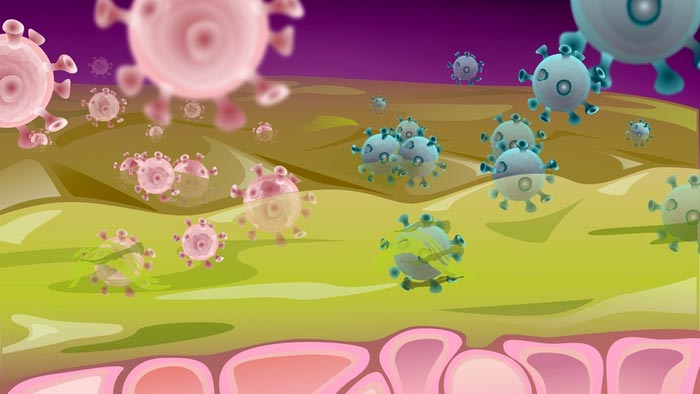Mucus-based lubricant proves highly effective against HIV and herpes

The synthetic gel replicates the self-healing function of mucus in the body: mucin molecules trap virus particles, such as HIV and herpes, which are then cleared through mucus turnover.
Credit: Cosmin Butnarasu
Cow mucus provides the basis for a synthetic prophylactic gel developed at KTH Royal Institute of Technology to protect against HIV and herpes transmission. The lubricating gel proved 70 percent effective in lab tests against HIV, and 80 percent effective against herpes.
The viral prophylactic tests were conducted in a lab on several types of cells. The results were reported today in the scientific journal, Advanced Science.
Hongji Yan, a biomaterials researcher at KTH, says the promising results raise hope that when it becomes available as a product, the gel could help reverse troubling trends in the spread of sexually transmitted infections. More than 1 million STIs are acquired every day worldwide and most of these are asymptomatic, according to the World Health Organization (WHO). AIDS, the disease caused by HIV, remains a significant global epidemic, and adolescent girls and young women are twice as likely as men to contract HIV as their male counterparts according to UNAIDS.
The lubricant is derived from mucin, a main component of mucus that is produced in the human body, though suppliers provide the bovine type in purified form for fabrication of hydrogels.
Hongji says the natural complexity of the mucin molecules is the reason the synthetic gel is so effective at stopping the HIV and herpes, without the risk of side effects or development of resistance as with other antiviral compounds. Such functions would be difficult to achieve with a polymer made from scratch, he says.
In our body, mucin molecules can bind to and trap virus particles, which are then cleared through active mucus turnover. Hongji says the synthetic gel replicates this self-healing function, which is a key material property that enables mucus’ lubricity and prophylaxis against infection.
Hongji says the gel could help more people take greater control of their sexual health. It could offer protection when condom protection is not an available option, or even as back-up protection in case of condom failure or incorrect use. It could be used in both female-to-male sex and male-to-male sex.
The mucins in the synthetic gel also help to dampen the activation of immune cells, he says. This is important because activated immune cells stimulate HIV replication.
The project is a collective effort of laboratories at KTH Royal Institute of Technology, the Technical University of Munich (TUM) and Karolinska Institutet. Analysis of the lubricating properties of the gel was performed by first author Martin Kretschmer at TUM. Viral tests were performed by first author Rafael Ceña-Diez at Karolinska Institutet.
Journal: Advanced Science
DOI: 10.1002/advs.202203898
Method of Research: Experimental study
Article Title: Synthetic Mucin Gels with Self-Healing Properties Augment Lubricity and Inhibit HIV-1 and HSV-2 Transmission
Article Publication Date: 14-Sep-2022
Media Contact
David Callahan
KTH, Royal Institute of Technology
callahan@kth.se
Office: 0737650593
All latest news from the category: Life Sciences and Chemistry
Articles and reports from the Life Sciences and chemistry area deal with applied and basic research into modern biology, chemistry and human medicine.
Valuable information can be found on a range of life sciences fields including bacteriology, biochemistry, bionics, bioinformatics, biophysics, biotechnology, genetics, geobotany, human biology, marine biology, microbiology, molecular biology, cellular biology, zoology, bioinorganic chemistry, microchemistry and environmental chemistry.
Newest articles

Innovative 3D printed scaffolds offer new hope for bone healing
Researchers at the Institute for Bioengineering of Catalonia have developed novel 3D printed PLA-CaP scaffolds that promote blood vessel formation, ensuring better healing and regeneration of bone tissue. Bone is…

The surprising role of gut infection in Alzheimer’s disease
ASU- and Banner Alzheimer’s Institute-led study implicates link between a common virus and the disease, which travels from the gut to the brain and may be a target for antiviral…

Molecular gardening: New enzymes discovered for protein modification pruning
How deubiquitinases USP53 and USP54 cleave long polyubiquitin chains and how the former is linked to liver disease in children. Deubiquitinases (DUBs) are enzymes used by cells to trim protein…



